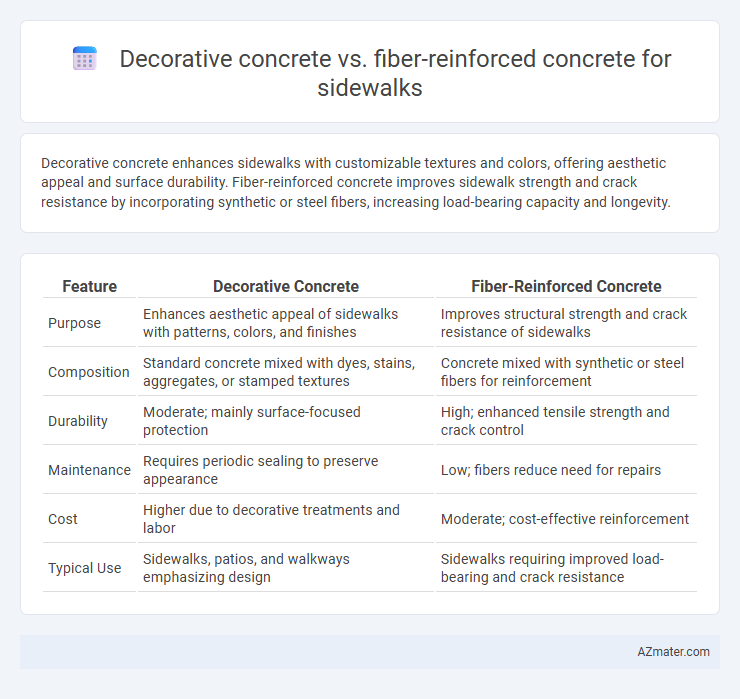Decorative concrete enhances sidewalks with customizable textures and colors, offering aesthetic appeal and surface durability. Fiber-reinforced concrete improves sidewalk strength and crack resistance by incorporating synthetic or steel fibers, increasing load-bearing capacity and longevity.
Table of Comparison
| Feature | Decorative Concrete | Fiber-Reinforced Concrete |
|---|---|---|
| Purpose | Enhances aesthetic appeal of sidewalks with patterns, colors, and finishes | Improves structural strength and crack resistance of sidewalks |
| Composition | Standard concrete mixed with dyes, stains, aggregates, or stamped textures | Concrete mixed with synthetic or steel fibers for reinforcement |
| Durability | Moderate; mainly surface-focused protection | High; enhanced tensile strength and crack control |
| Maintenance | Requires periodic sealing to preserve appearance | Low; fibers reduce need for repairs |
| Cost | Higher due to decorative treatments and labor | Moderate; cost-effective reinforcement |
| Typical Use | Sidewalks, patios, and walkways emphasizing design | Sidewalks requiring improved load-bearing and crack resistance |
Introduction to Concrete Sidewalk Options
Decorative concrete offers customizable aesthetics such as stamped patterns and color designs, enhancing curb appeal for sidewalks. Fiber-reinforced concrete incorporates synthetic or steel fibers to improve tensile strength, durability, and crack resistance, making it ideal for high-traffic pedestrian areas. Choosing between decorative and fiber-reinforced concrete depends on balancing visual appeal with structural performance requirements for sidewalk applications.
Understanding Decorative Concrete
Decorative concrete enhances sidewalks with customizable textures, colors, and patterns that mimic natural materials like stone or brick, providing both aesthetic appeal and durability. Unlike fiber-reinforced concrete, primarily valued for its increased tensile strength and crack resistance through embedded synthetic or steel fibers, decorative concrete focuses on visual enhancement and surface treatments such as stamping, staining, and polishing. This makes decorative concrete an ideal choice for projects where curb appeal and design versatility are prioritized alongside standard structural performance.
What is Fiber-Reinforced Concrete?
Fiber-reinforced concrete (FRC) incorporates synthetic or steel fibers to improve tensile strength, reduce cracking, and enhance durability compared to traditional concrete used in sidewalks. Decorative concrete primarily emphasizes aesthetic appeal with patterns, colors, and textures, whereas fiber-reinforced concrete focuses on structural integrity and resistance to impact and wear. For sidewalk applications, FRC offers superior performance under heavy foot traffic and environmental stress, extending the service life and minimizing maintenance costs.
Aesthetic Appeal: Decorative vs Fiber-Reinforced
Decorative concrete offers a wide range of aesthetic options including stamped patterns, color stains, and intricate textures that enhance sidewalk visual appeal and customization. Fiber-reinforced concrete provides a more utilitarian look, primarily focused on improving structural integrity and crack resistance rather than decorative finishes. Choosing decorative concrete is ideal for projects prioritizing artistic design, while fiber-reinforced concrete suits applications emphasizing durability with minimal aesthetic modifications.
Strength and Durability Comparison
Decorative concrete enhances sidewalks with aesthetic patterns and color while maintaining moderate strength, suitable for pedestrian traffic but less resistant to heavy loads. Fiber-reinforced concrete incorporates polypropylene or steel fibers, significantly improving tensile strength, crack resistance, and durability under varying weather conditions. Sidewalks using fiber-reinforced concrete exhibit superior longevity and reduced maintenance compared to decorative concrete, especially in high-stress or freeze-thaw environments.
Maintenance Requirements
Decorative concrete sidewalks demand regular sealing and cleaning to preserve aesthetic appeal and prevent surface stains or wear. Fiber-reinforced concrete enhances durability and reduces cracking, significantly lowering long-term maintenance for structural integrity. Choosing fiber-reinforced concrete can minimize repair frequency and extend the lifespan of sidewalks compared to purely decorative concrete surfaces.
Installation Process and Costs
Decorative concrete for sidewalks involves stamping, staining, or engraving techniques that require skilled labor and specialized tools, typically leading to higher upfront installation costs ranging from $10 to $18 per square foot. Fiber-reinforced concrete incorporates synthetic or steel fibers into the mix to improve durability and crack resistance with a standard pour method, generally costing between $4 and $7 per square foot for installation. The installation process for fiber-reinforced concrete is faster and less labor-intensive, resulting in lower labor costs and quicker project completion compared to the detailed finishing steps required for decorative concrete.
Slip Resistance and Safety
Decorative concrete offers customizable textures and finishes that enhance slip resistance for sidewalks, reducing the risk of slips and falls in wet or icy conditions. Fiber-reinforced concrete integrates synthetic or steel fibers into the mix, improving structural integrity and preventing surface cracking, which indirectly contributes to safer walking surfaces. Both materials prioritize pedestrian safety, but fiber reinforcement provides superior durability while decorative concrete excels in aesthetic-driven slip resistance.
Environmental Impact
Decorative concrete for sidewalks often involves the use of pigmented dyes and surface treatments that can introduce volatile organic compounds (VOCs), impacting local air quality. Fiber-reinforced concrete incorporates synthetic or natural fibers that enhance durability and reduce the need for frequent repairs, thereby decreasing aggregate consumption and waste generation over time. Choosing fiber-reinforced concrete can lead to lower environmental footprints due to its extended lifespan and reduced maintenance requirements compared to traditional decorative concrete finishes.
Which Concrete Type is Best for Your Sidewalk?
Decorative concrete offers customizable aesthetics and surface textures ideal for enhancing sidewalk appearance, while fiber-reinforced concrete provides superior durability and crack resistance through integrated synthetic or steel fibers. For sidewalks subjected to heavy foot traffic or harsh weather conditions, fiber-reinforced concrete delivers long-term structural strength and reduced maintenance needs. Selecting the best concrete type depends on whether visual appeal or enhanced performance and longevity are the priorities for your sidewalk project.

Infographic: Decorative concrete vs Fiber-reinforced concrete for Sidewalk
 azmater.com
azmater.com